Italian Hospital
40-41 Queen Square, WC1N 3AJ
Medical dates:
Medical character:
1884 - 1990
General
The Ospedale Italiano was founded in 1884 by a successful Italian businessman, Commendatore Giovanni Battista (John) Ortelli, who had become aware of the language difficulties faced by his compatriots in London hospitals.
The Commendatore donated two houses in Queen Square which
were later demolished and a new building erected in 1898. The
main wards were in the front of the building, with smaller ones at the
back along with single rooms for private patients or cases that needed
to be isolated. For infectious cases, there was a separate block
at the back of the building, with its own bathroom and kitchen and
bedroom for the nurse in attendance. The Hospital chapel was
at the top of the main building, with a corridor past it leading to the
flat roof, where convalescent patients could play games and enjoy the
fresh air. The Hospital had a large passenger lift, as well as a
service lift for food to be sent from the kitchen to the wards.
The Sisters of St Vincent de Paul, with their distinctive
uniforms, provided the nursing care.
While preference was given to Italians, the Hospital treated any needy
person - almost half its patients were British - and it became
a respected medical facility, attracting highly qualified staff.
Funds for the Hospital were raised from subscribers in Britain
and Italy.
In 1910 the Hospital was extended when two houses behind it were acquired.
During WW1 the Hospital was affiliated to the Fourth London General Hospital, with 60 of its beds reserved for sick and wounded servicemen.
In 1933 a group of British Fascists endowed a bed at the cost of 1000
guineas (£1050) dedicated to Il Duce, Benito Mussolini, who sent
a telegram acknowledging the gift as "proof of the friendly spirit of
cooperation which unites the people of the two countries".
The governors of the Hospital were lay members, unlike most other
voluntary specialist hospitals, and this sometimes led to friction
between management and the clinical staff. In 1935 the entire
medical staff resigned because they felt doctors were being appointed
without suitable qualifications.
Friction appeared again in 1937, this time between the British and
Italian governors. The Italians insisted on having more control
and the British resigned in protest.
The Hospital, with 53 beds, was forced to close in 1941, when Italy entered WW2.
It re-opened in 1946 with 48 beds, but did not join the NHS in 1948 and continued as an independent hospital.
The Hospital played an important part in the Italian community - the
'Little Italy' of Clerkenwell - but the establishment of the NHS in
1948, the changing needs of the community and the running expenses all
combined to make its upkeep difficult. Financial problems forced
its closure in 1990.
|
Present status (September 2008)
UPDATE (April 2019) The building is currently undergoing major remodelling and refurbishment to bring it back into clinical use. It is planned to reopen in Spring 2020 as the Great Ormond Street Hospital Sight and Sound Centre, accommodating out-patient clinics for ophthalmology, audiology, ENT and related services. A significant part of the £25 million cost of the project has been donated by Premier Inn.
UPDATE (November 2023) The Sight and Sound Centre GOSH opened in June 2021. The former hospital chapel has been deconsecrated and its altar moved to another church. The room is used as a restroom and lunch area for the staff.
|
|---|
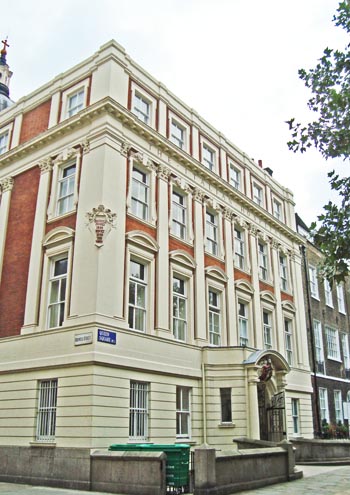
The former Hospital building on the corner of Queen Square and Boswell Street.
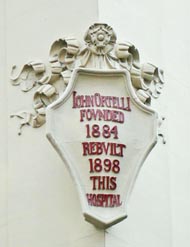
The plaque to the Commendatore on the corner of the building.
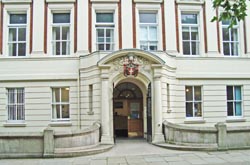
The main entrance (above) with the coat-of-arms above the door (below).
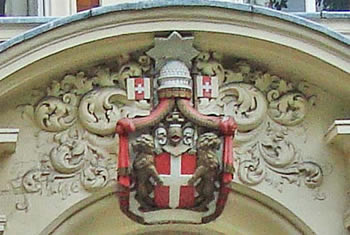

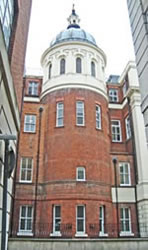
The eastern elevation along Boswell Street (left), with the tower, as seen from Ormond Close, which joins the two buildings of the former Hospital (right).

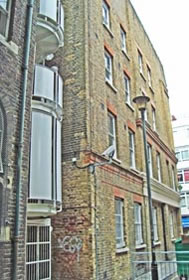
Looking north along Boswell Street towards Queen Square (left). The southern elevation along an alley joining Boswell Street to Old Goucester Street (right).
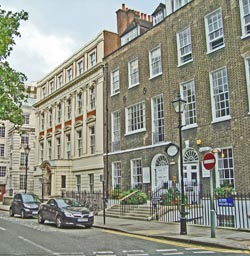
The white stucco building of the former Italian Hospital is next door to the Mary Ward Centre on the southern side of Queen Square.
References (Accessed 8th April 2019)
(Author unstated) 1901 The Italian Hospital, Queen Square. Nursing Record and Hospital World, 21st December, 503.
(Author unstated) 1917 List of the various hospitals treating military cases in the United Kingdom. London, H.M.S.O.
(Author unstated) 1933 The Hospital World. British Journal of Nursing (June), 174.
Black N 2006 Walking London's Medical History. London, Royal Society of Medicine Press.
http://collage.cityoflondon.co.uk
https://britishlistedbuildings.co.uk
https://collections.nlm.nih.gov
https://images.historicenglandservices.org.uk